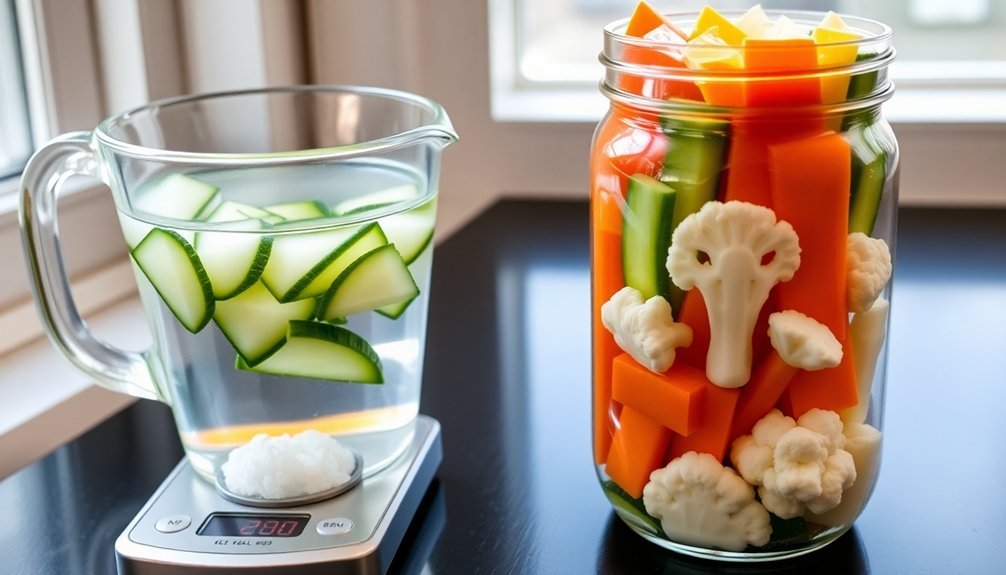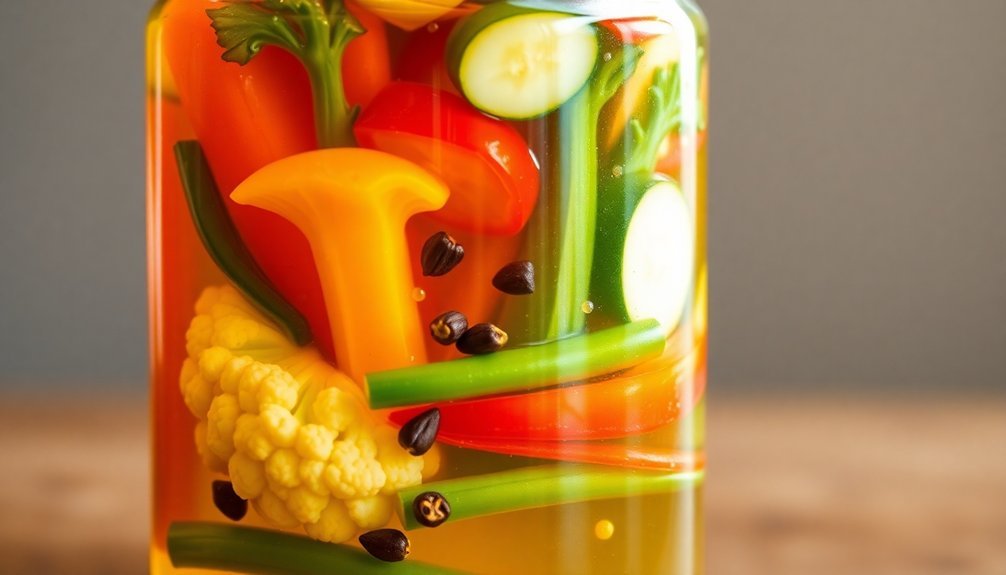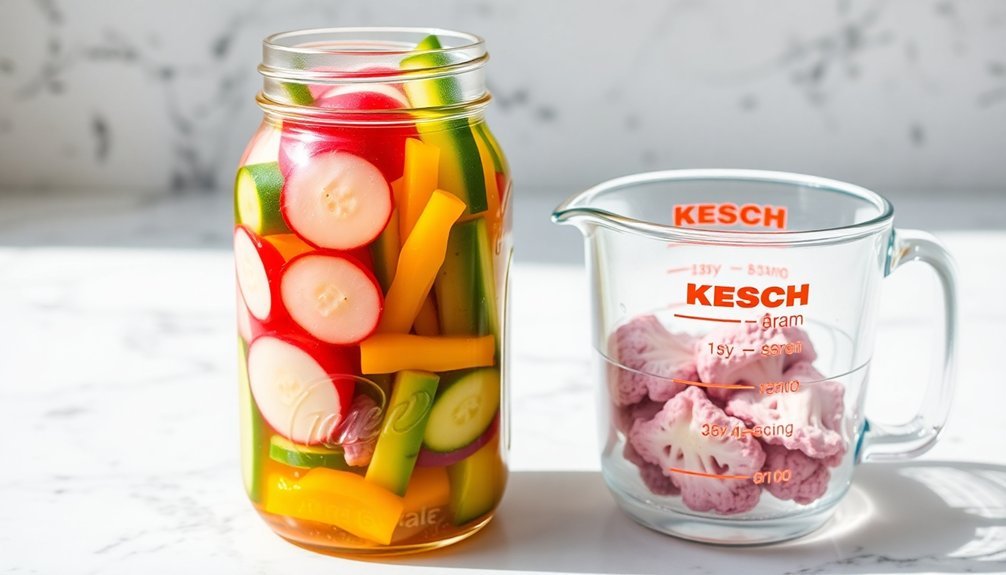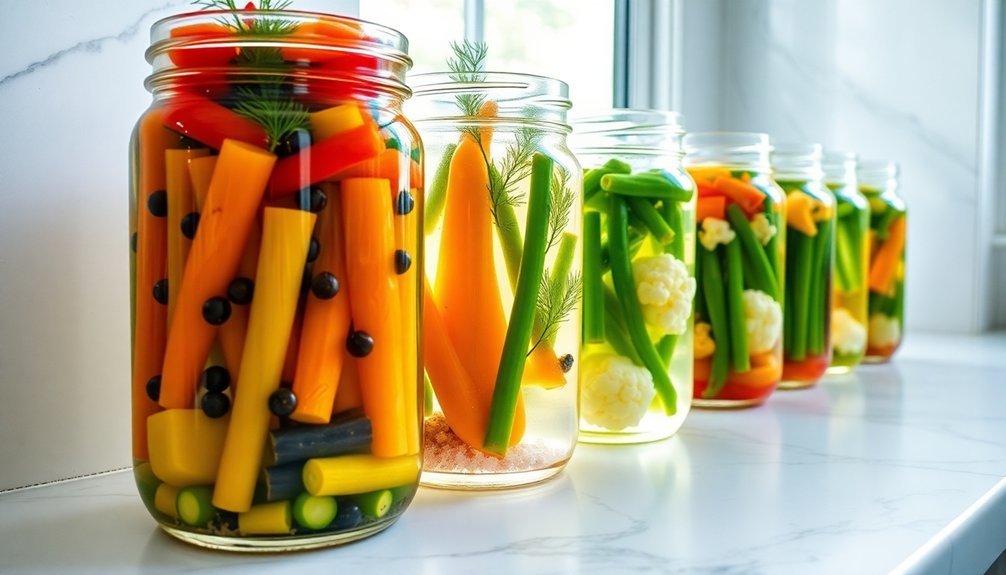The ideal brine ratio depends on your vegetables' texture and fermentation goals. You'll get crisp results with a basic 2% solution (20g salt per liter) for most mixed vegetables, while root vegetables need a slightly stronger 2.2% brine. For delicate summer vegetables like broccoli and cauliflower, stick to a gentle 2-2.5% ratio. Cucumbers require a more robust 2.2-3% concentration to maintain crunchiness. When fermenting softer vegetables like asparagus or mushrooms, opt for a reliable 3% all-purpose brine. Each ratio offers unique benefits for texture and flavor development, with proper techniques promising consistently crisp results.
Basic Two Percent Brine

A basic two percent brine serves as the foundation for most vegetable fermentation projects. You'll find this ratio works perfectly for fermenting a wide variety of vegetables, including carrots, asparagus, green beans, broccoli, and cauliflower.
To create this brine, you'll need 20 grams (4 teaspoons) of salt per liter of water. Creating the right concentration is straightforward – if you're using a 500ml jar, simply use 10 grams (2 teaspoons) of salt. The salt will dissolve naturally in the water, creating an environment that promotes beneficial bacteria while inhibiting unwanted microorganisms. Using chlorine-free water is essential for successful fermentation.
When you're preparing your vegetables, place them in the jar and guarantee they're completely submerged in the brine. This submersion creates an anaerobic environment essential for proper fermentation. You can add fresh herbs to enhance flavor and help prevent mold growth.
The brine will gradually extract water from your vegetables, forming a nutrient-rich solution that enhances the fermentation process. This two percent concentration effectively preserves the vegetables' crispy texture by slowing enzymatic activity while allowing the development of those desirable lacto-fermentation flavors you're looking for.
Traditional Root Vegetable Mix
Root vegetable mixtures provide an excellent starting point for fermentation projects, combining the earthy flavors of beetroot, carrots, and celeriac with complementary vegetables like turnips, parsnips, and winter radishes. Adding these vegetables together will create a light pink hue from the beets, giving your mix a lovely tinted appearance.
You'll want to include a variety of colors and textures, from golden and purple top turnips to vibrant watermelon radish and daikon.
To prepare your root vegetable mix, peel and chop your selections into uniform shapes. Blanch them in boiling water for 1.5 minutes, then quickly transfer to cold water to maintain their crispness and color.
Once drained, you can pack them tightly into fermentation jars with your choice of aromatics like bay leaves, peppercorns, and garlic cloves.
- Watch in amazement as your humble root vegetables transform into tangy, probiotic-rich delicacies
- Experience the satisfying crunch of perfectly fermented turnips and radishes
- Delight in the rainbow of colors from golden beets to purple-topped turnips
- Enjoy the complex layers of flavor from your carefully chosen spice blend
- Take pride in carrying on an age-old tradition of food preservation
Cover your vegetables completely with a 2.2% salt brine solution and guarantee they stay submerged throughout the 9-14 day fermentation period.
Gentle Summer Garden Blend

Creating invigorating summer ferments calls for a lighter touch than root vegetable blends. For your gentle summer mix, you'll want to maintain a consistent 2-2.5% brine ratio across all vegetables to guarantee balanced fermentation. This translates to roughly 40 grams of non-iodized salt per liter of water.
Start with a bright mix of broccoli, cauliflower, carrots, green beans, and celery. These vegetables work harmoniously together and share similar fermentation needs. You'll need to cut each vegetable into uniform, smaller pieces to help the brine penetrate effectively. Use filtered water only to ensure harmful chlorine doesn't inhibit fermentation.
Don't include winter squash, as it won't ferment properly.
Pack your jar tightly with the vegetable mixture, then pour your prepared brine solution over them until they're completely submerged. If you'd like to enhance the flavors, add 2-3 teaspoons of your preferred spice mix to the brine before pouring.
Place your jar on the counter with a catch plate underneath to handle any overflow during fermentation. You'll need to check periodically and push down any floating vegetables. The fermentation process will take several days to weeks, depending on your desired flavor intensity.
High-Salt Cucumber Medley
Crisp cucumber fermentation requires a stronger brine ratio than summer vegetables, typically ranging from 2.2% to 3.0% salt concentration.
You'll need to calculate salt based on the total weight of both cucumbers and water in your jar. For a quart jar, measure out 3 teaspoons of salt to achieve a 2.2% brine that prevents mold while maintaining crispness.
Pack your cucumbers tightly with garlic cloves and dill sprigs, ensuring they stay submerged beneath the brine.
Monitor your fermentation daily in a cool spot between 60-75°F, watching for cloudy brine and tiny bubbles. You'll want to burp the jar or use an airlock to release building pressure.
After 3-5 days, you'll have a light pickle; for tangier results, let it ferment up to 2 weeks before refrigerating.
- Feel the satisfaction of hearing that first crisp crunch
- Experience the joy of watching tiny bubbles rise as fermentation begins
- Savor the pride of maintaining your family's pickle-making tradition
- Delight in the natural transformation of raw cucumber to probiotic pickle
- Celebrate your success when sharing your perfectly crisp pickles with friends
All-Purpose Three Percent Solution

A reliable 3% brine solution serves as your go-to formula for fermenting softer vegetables like asparagus, mushrooms, and broccoli florets. To achieve this ratio, you'll need to calculate 3 grams of salt for every 100 grams of total mixture, including both water and vegetables.
Start with filtered water to protect the beneficial lactobacillus bacteria, and use unprocessed salt without additives or anti-caking agents. You'll want to weigh your salt with a digital scale rather than rely on volume measurements, as salt density can vary considerably. Remember that your jar's volume in milliliters equals the weight in grams, making calculations straightforward.
Select the freshest, crispiest vegetables you can find, as older produce won't ferment properly. After washing them lightly, cut your vegetables to your preferred size and submerge them completely in the brine. You can keep them under the surface using a brine-filled plastic bag or vegetable leaves as weights.
Monitor your fermentation regularly – while cloudy brine is normal, you'll want to watch for proper texture development. Your vegetables should maintain their crispness throughout the process, which typically takes several days to weeks.
Frequently Asked Questions
Can I Reuse Leftover Brine From a Previous Batch of Fermented Vegetables?
Yes, you can reuse leftover brine from fermented vegetables. Store it in a clean glass jar in your fridge for up to six months, and use it as a starter culture or flavor enhancer in new ferments.
How Long Should I Wait Before Tasting My Fermented Mixed Vegetables?
You should wait at least 3 days before tasting your fermented vegetables. After that, you can taste them daily until they reach your preferred flavor level. Don't forget to use clean utensils.
Why Did My Vegetables Turn Mushy Despite Following the Correct Brine Ratio?
Even with the right brine ratio, your vegetables can turn mushy if they're not fully submerged, you've fermented too long, or you haven't considered the vegetable type's density and water content. Check submersion regularly.
What Causes White Film on Top of My Fermenting Vegetables?
The white film on your fermenting vegetables is likely kahm yeast, caused by too little salt, high temperatures, or oxygen exposure. While it's not harmful, you'll want to skim it off to maintain flavor.
Should I Rinse Vegetables After Brining if They Taste Too Salty?
Yes, you can rinse your brined vegetables if they're too salty. Use cold water for a quick rinse, but keep in mind it'll slightly affect the flavor and might reduce crispiness in your fermented veggies.
In Summary
You'll find these five brine ratios give you consistently crisp pickled vegetables, whether you're working with hardy root vegetables or delicate summer produce. Start with the basic two percent solution if you're new to pickling, then experiment with stronger brines as you gain confidence. Remember to always measure salt by weight rather than volume for the best results and crunchiest pickles.





Leave a Reply